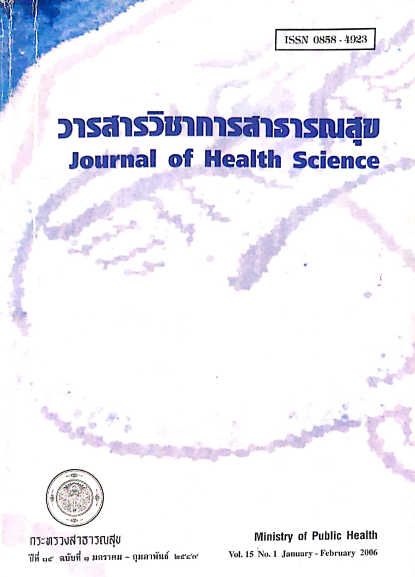Promoting Parenteral-Oral Drug Switching for Hospitalized Patients - การส่งเสริมการแทนยาฉีดด้วยยากิน สำหรับผู้ป่วยที่นอนพักรักษาในโรงพยาบาล
บทคัดย่อ
Abstract
A quasi experiment was conducted at Lampang Hospital during October 2003 - November 2004 to determine the effectiveness of the multifaceted group interventions in promoting parenteral oral (IV-PO) drug switching for hospitalized patients and to survey an attitude of physician towards IV-PO switching program. Medical charts of inpatients who were prescribed target IV drugs more than 24 hours were reviewed prospectively by a clinical pharmacist for two weeks in each phase; phase I as a baseline period, phase II as 2 months after intervention, and phase III as six months after intervention. Candidates for the switching were identified according to the hospital guideline. Excess days, durations of IV drug use, and potentially avoidable costs were determined. The generalized linear model was used to adjust relevant factors in the multivariate analysis.
Of all reviewed hospitalized patients, 629, 647 and 593 were prescribed the target IV medications that comprised 940, 1,007 and 917 prescriptions in phases I, II and III, respectively. According to the switching guideline, 25.7 percent, 19.7 percent and 24.2 percent of prescriptions were identified as the candidates in phases I, II and III, respectively. The multifaceted group interventions could significantly reduce only an incidence of switching candidate in short-term period (p<0.05), but not the other expected outcomes both in short-term and long-term periods. After six months, significant improvement could no longer be observed. Based on the physician opinions, more than 90 percent agreed with the implementing of IV-PO switching program in the hospital, more than 80 percent thought that the most effective strategy in promoting IV-PO drug switching was clinical practice guideline. implementation whereas about 20 percent thought that the most effective was policy implementation. The physicians preferred communication with pharmacists via direct contact (44.2%) to via written form (28.9%). Since the multifaceted group interventions could reduce only incidence of switching candidates for a short while, it should be implemented along with a specific reminder system to increase the effectiveness of the IV-PO switching program in the hospital.
Key words: pharmacist, impact, promotion, IV-PO switching, hospitalized patients
บทคัดย่อ
การศึกษาผลการส่งเสริมระบบการแทนยาฉีดด้วยยากินแบบผสมผสานโดยใช้นโยบายของโรงพยาบาล การจัดประชุมวิชาการและการให้ข้อมูลแก่แพทย์เป็นรายกลุ่ม และสำรวจความคิดเห็นของแพทย์ต่อระบบดังกล่าว โดยศึกษาผู้ป่วยในของโรงพยาบาลลำปาง ซึ่งได้รับยาฉีดเป้าหมายเพื่อการรักษามากกว่า ๒๔ ชั่วโมง เก็บข้อมูลใน ๓ ช่วงเวลา ระหว่างตุลาคม ๒๕๕๖ ถึงพฤศจิกายน ๒๕๔๗ ช่วงละ ๑๕ วัน ก่อนดำเนินการและหลังดําเนินการ ๒ เดือน และ ๖ เดือน เพื่อหาผู้ป่วยและรายการยาฉีดที่ควรเปลี่ยนเป็นยากินตามแนวทางที่กำหนด คำนวณอุบัติการณ์ของโอกาสแทนยา จำนวนวันฉีดยาเกิน จำนวนวันฉีดยารวม และมูลค่าที่สูญเสีย อาจเกิดจากการฉีดยาเกิน วิเคราะห์ผลลัพธ์ของการดำเนินการแบบตัวแปรพหุเมื่อควบคุมตัวแปรที่สำคัญที่เกี่ยวข้องโดยใช้ generalized linear model
จากการทบทวนประวัติของผู้ป่วยที่ได้รับยาฉีดเป้าหมาย ๖๒๙ คน ๖๔๗ คน และ ๕๙๓ คน มีการสั่งใช้ยา ๙๔๐ ครั้ง ๑,๐๐๗ ครั้ง และ ๙๑๗ ครั้ง พบอุบัติการณ์ของการสั่งยาที่มีโอกาสแทนยา คิดเป็นร้อยละ ๒๕.๗, ๑๙.๑ และ ๒๔.๒ ในช่วงที่ ๑, ๒ และ ๓ ตามลำดับ ผลลัพธ์หลังการส่งเสริมการแทนยา พบอุบัติการณ์ของการสั่งยาที่มีโอกาสแทนยาลดลงอย่างมีนัยสำคัญ ในระยะสั้นที่ ๒ เดือนหลังมีการส่งเสริมการแทนยา (p<๐.๐๕) แต่ผลลัพธ์อื่นซึ่งได้แก่ จำนวนวันฉีดยาเกิน จำนวนวันฉีดยารวม และมูลค่าการสูญเสีย ไม่พบการเปลี่ยนแปลงอย่างมีนัยสำคัญทางสถิติทั้งที่ ๒ เดือนและ ๖ เดือน และที่ ๖ เดือนพบว่าผลลัพธ์ทุกตัวมี ค่าใกล้เคียงกับก่อนดำเนินการส่งเสริมการแทนยา จากการสอบถามความคิดเห็นของแพทย์ พบว่าแพทย์มากกว่าร้อยละ ๙๐ เห็นด้วยกับการมีระบบการแทนยาฉีดด้วยยากิน และร้อยละ ๘๒.๗ เห็นว่าวิธีการส่งเสริมการแทนยาที่ได้ผลมากที่สุดคือการทำแนวทางในการปฏิบัติ (clinical practice guideline) เพียงร้อยละ ๒๑.๒ ที่เห็นว่าการกำหนดนโยบายเป็นวิธีที่ได้ผลดี แพทย์พอใจที่จะรับคำปรึกษาโดยการติดต่อด้วยตนเอง (ร้อยละ ๔๔.๒) มากกว่าการเขียนใบปรึกษา (ร้อยละ ๒๘.๙) ดังนั้น การส่งเสริมเชิงนโยบายและการให้ข้อมูลเป็นรายกลุ่ม อาจไม่ได้ผลลัพธ์ตามเป้าหมาย จึงควรนำมาประยุกต์ใช้ร่วมกับวิธีการส่งเสริมอื่นที่มีรายงานว่ามีประสิทธิภาพเช่นการจัดให้มีระบบเตือนแพทย์ผู้สั่งยาอย่างสม่ำเสมอและต่อเนื่อง ใช้วิธีปรึกษาที่แพทย์พอใจ จะทำให้เกิดระบบการแทนยาที่มีประสิทธิภาพในโรงพยาบาล
คำสำคัญ: เภสัชกร, ผลกระทบ, การส่งเสริม, การแทนยาฉีดด้วยยากิน, ผู้ป่วยใน





